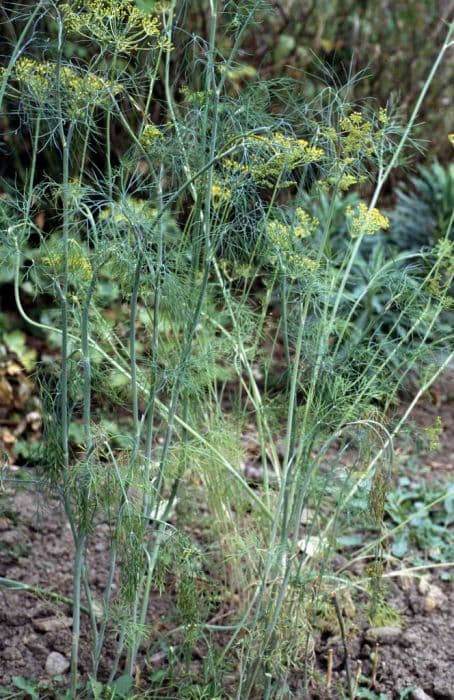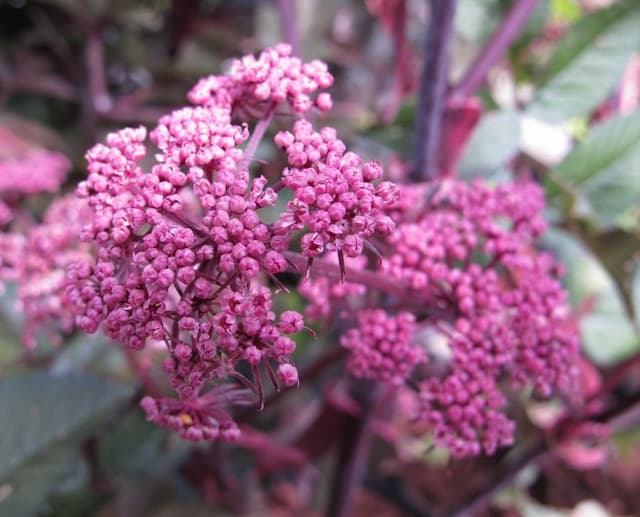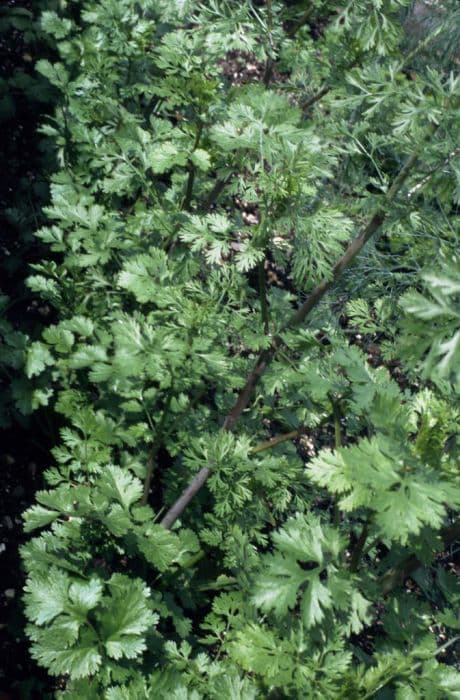Perfoliate Alexanders Smyrnium perfoliatum






ABOUT
Smyrnium perfoliatum, commonly known as Perfoliate Alexanders, is a striking plant with a noticeable appearance due to its unique foliage and flowering habit. The leaves are a vibrant green, and they form a cupped or clasping arrangement around the stout stems. This characteristic, known as perfoliate, means the stem seems to grow through the center of the leaf, creating a joined appearance at the base of the leaf pairs. The plant typically has a lush, leafy presence, with the leaves getting smaller as they ascend the stems. As for the flowers, Perfoliate Alexanders produce small, yellow-green flowers that are densely packed into umbrella-like clusters, known as umbels. These clusters are relatively flat-topped and can give the plant a distinctive decorative look. The flowers then give way to green fruits that gradually turn black as they mature. These fruits are slightly flattened and oval, contributing to the decorative nature of the plant even after the flowering season has ended. Overall, Perfoliate Alexanders have a robust, verdant appearance that stands out in woodland settings or among other plants in a garden.
About this plant
 Names
NamesFamily
Apiaceae
Synonyms
Perfoliate Alexanders, Perfoliate Smyrnium
Common names
Smyrnium perfoliatum.
 Toxicity
ToxicityTo humans
Smyrnium perfoliatum, commonly known as Alexanders, is not generally considered toxic to humans. There are no well-documented cases of toxicity or poisoning from consuming Alexanders. However, as with any plant, some individuals might experience adverse reactions due to allergies or sensitivities. It is always advisable to exercise caution and consult with a professional before consuming any wild plants.
To pets
Smyrnium perfoliatum, or Alexanders, is not widely recognized as a toxic plant to pets such as dogs and cats. There is limited specific information on its effects on domestic animals. However, individual pets may have different levels of sensitivity, and consuming large quantities of any non-typical food can potentially lead to gastrointestinal upset or other health issues. Therefore, it is prudent to prevent pets from ingesting this plant, especially in large amounts, and to consult with a veterinarian if any signs of illness appear after ingestion.
 Characteristics
CharacteristicsLife cycle
Biennials
Foliage type
Deciduous
Color of leaves
Green
Flower color
Yellow
Height
3 feet (0.91 meters)
Spread
1.5 feet (0.46 meters)
Plant type
Herb
Hardiness zones
Varies
Native area
Europe
Benefits
 General Benefits
General Benefits- Culinary uses: Smyrnium perfoliatum, commonly known as perfoliate alexanders, has edible parts like leaves, stems, and seeds that can be used in cooking, offering a unique flavor to various dishes.
- Attracts wildlife: The flowers of the perfoliate alexanders attract beneficial insects to the garden, such as bees and butterflies, which are essential for pollination.
- Ornamental value: With its distinctive perfoliate leaves, where the stem appears to grow through the center of the leaf, and yellow-green flowers, this plant adds an aesthetic appeal to gardens and landscapes.
- Heritage and history: Perfoliate alexanders has a long history of cultivation, and growing it can provide a connection to historical gardening practices and plant uses.
- Companion planting: It can be used in companion planting to benefit other plants in the garden, though the specifics of these relationships are less well-documented.
 Medical Properties
Medical Properties- Antibacterial: Smyrnium perfoliatum has been traditionally used for its antibacterial properties against various bacterial strains.
- Anti-inflammatory: The plant may possess anti-inflammatory effects, which could help reduce inflammation in certain conditions.
- Diuretic: Historically, it has been used to increase urine production and relieve fluid retention.
- Expectorant: Smyrnium perfoliatum is sometimes used to help expel phlegm from the respiratory tract.
 Air-purifying Qualities
Air-purifying QualitiesThis plant is not specifically known for air purifying qualities.
 Other Uses
Other Uses- Natural dye: The leaves of Alexanders can be used to produce a green dye for textiles.
- Garden plant: Alexanders are grown for ornamental purposes due to their attractive foliage and umbels of yellowish-green flowers.
- Aromatic herb: The seeds can be used as a flavoring agent similar to myrrh, known for its aromatic properties.
- Companion planting: Alexanders may be planted among vegetables to deter pests with its distinctive aroma.
- Culinary garnish: The young leaves and stems are edible and can be used as a garnish for a variety of dishes.
- Wildlife habitat: The plant provides a habitat and food source for beneficial insects and pollinators in the garden.
- Photography subject: Due to its unique appearance when in bloom, it can be an interesting subject for botanical photography.
- Soil improver: Being a deep-rooted plant, Alexanders can help to break up heavy soils and improve soil structure.
- Traditional ceremonies: In certain cultures, the plant has been used in traditional ceremonies and celebrations.
- Floral arrangements: The tall stems and structured umbels of Alexanders can be used in fresh or dried floral arrangements.
Interesting Facts
 Feng Shui
Feng ShuiThe Smyrnium perfoliatum, commonly known as Alexanders, is not used in Feng Shui practice.
 Zodiac Sign Compitability
Zodiac Sign CompitabilityAlexanders is not used in astrology practice.
 Plant Symbolism
Plant Symbolism- Elusiveness: As Smyrnium perfoliatum, commonly known as "Perfoliate Alexanders," isn't widely recognized, it often symbolizes the allure of the rare and the elusive.
- Renewal: Like many other green plants, it suggests themes of growth and renewal due to its lush foliage and life cycle.
- Invisibility: Its tendency to blend into the surrounding flora without standing out can symbolize invisibility or the desire to go unnoticed.
- Adaptation: Perfoliate Alexanders’ ability to grow in various conditions can represent adaptability and resilience in the face of change.
 Water
WaterFor Alexanders (the common name of Smyrnium perfoliatum), ensure consistent moisture by watering it deeply once a week, providing about 1 to 1.5 inches of water. During dry periods or hot weather, increase the frequency to twice a week. Use a watering can or a hose with a gentle spray setting to avoid disturbing the soil around the roots. It is better to water in the morning to allow the foliage to dry before evening. Over-watering can lead to root rot, so allow the soil to dry out slightly between watering sessions.
 Light
LightAlexanders thrives best in partial shade to full sun. However, in areas with very hot summers, it is beneficial to provide some afternoon shade to prevent scorching. A spot that receives morning sunlight and dappled shade in the afternoon is ideal for the balanced growth of this plant.
 Temperature
TemperatureAlexanders grows optimally at temperatures between 60°F and 75°F. It is hardy and can withstand temperatures down to around 20°F. During the active growing season, maintain temperatures within the ideal range, as extreme heat or frost can be detrimental.
 Pruning
PruningPruning of Alexanders is not usually necessary, as it is a biennial plant that dies back after seeding. However, if there is a need to shape the plant or remove spent flowers, the best time to do so is after blooming has finished. Deadheading the flowers before they set seed can sometimes stimulate a second bloom.
 Cleaning
CleaningAs needed
 Soil
SoilPerfoliate Alexanders prefer a fertile, well-draining soil mix with a pH ranging from 6.5 to 7.5. A mix of garden soil, compost, and sand in equal parts can create an ideal growing medium.
 Repotting
RepottingPerfoliate Alexanders generally do not need frequent repotting; it can be done every 2-3 years or when the plant outgrows its current container.
 Humidity & Misting
Humidity & MistingPerfoliate Alexanders thrive in moderate humidity levels but are adaptable to a wide range as long as soil moisture is well-regulated.
 Suitable locations
Suitable locationsIndoor
Grow in bright light with moist, rich soil.
Outdoor
Provide partial shade and rich, well-drained soil.
Hardiness zone
7-9 USDA
 Life cycle
Life cycleSmyrnium perfoliatum, commonly known as perfoliate alexanders, starts its lifecycle as a seed which germinates in the spring. After germination, it develops a basal rosette of leaves during the first year, remaining in a vegetative state. In the second year, it bolts, sending up a flowering stalk; it then undergoes flowering, usually in late spring or early summer. The flowers are yellow-green and are pollinated by a variety of insects to produce seeds in characteristic umbels. Once the seeds mature, they are dispersed by wind or animal activity, completing the reproductive cycle. Perfoliate alexanders is a biennial plant, meaning it typically completes its lifespan in two years.
 Propogation
PropogationPropogation time
Spring
The most popular method of propagating Smyrnium perfoliatum, commonly known as the Perfoliate Alexanders, is through its seeds. Optimal timing for sowing the seeds is during the fall, directly after they mature. Sowing the seeds at this time allows them to experience a natural stratification process during the winter, which helps to break the seed dormancy. Seeds should be planted about 1/4 inch deep in the soil and spaced to allow room for growth. They prefer a shaded area with well-draining soil. Germination typically occurs in the spring, and the seedlings can then be carefully transplanted to their final growing positions when they are large enough to handle.








